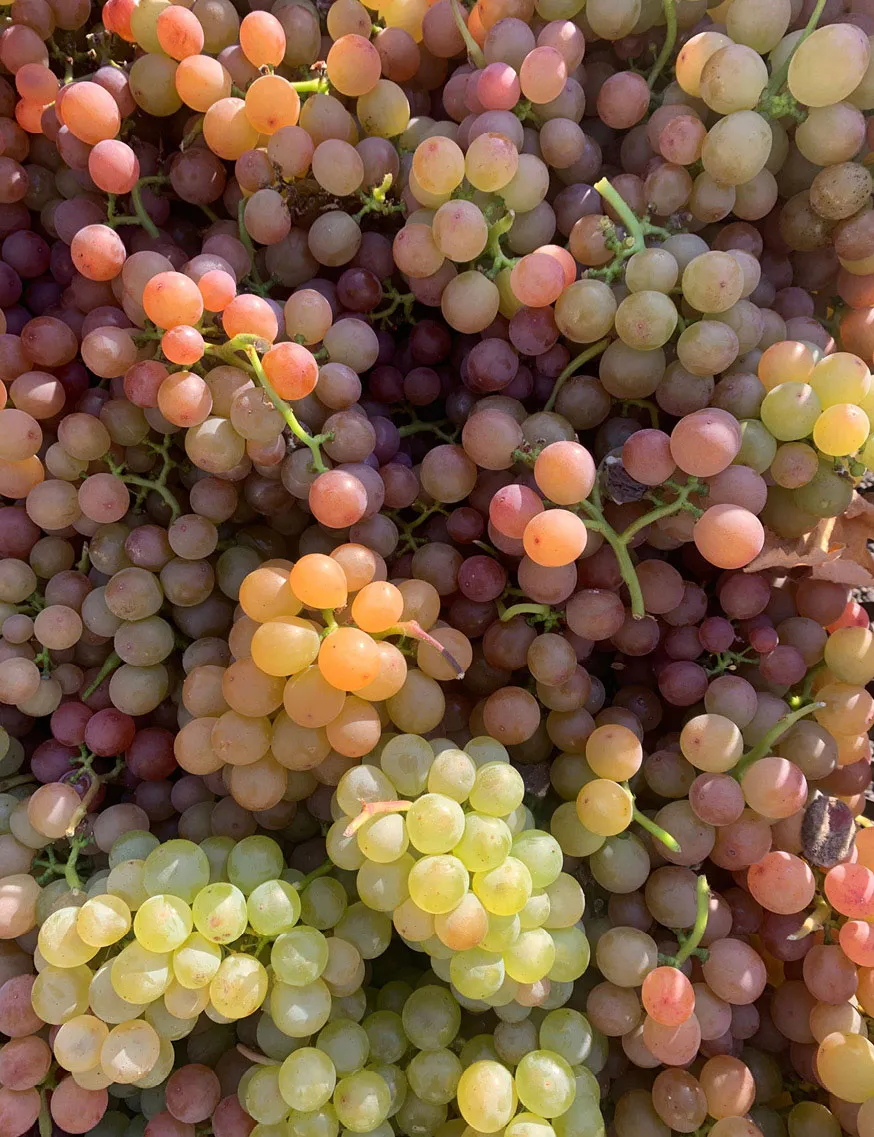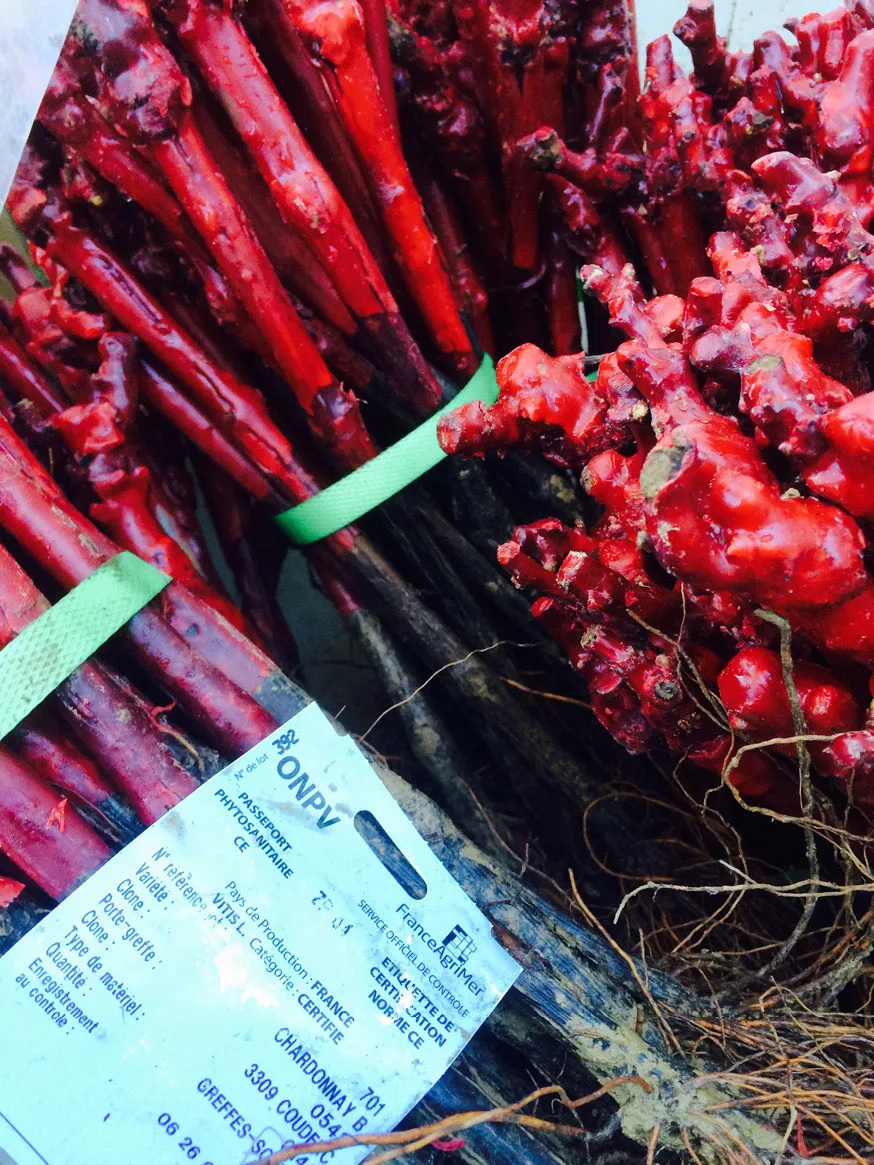![]()
CHAPTER 1
GRAPE VARIETIES AND SITE SELECTION
The classic sparkling wine varieties of Chardonnay, Pinot Noir and Pinot Meunier have captured the imagination with recent plantings in the UK. However, research into what will realistically grow in your vineyard location is of vital importance if your project is to be successful.
Vines enjoying the glorious weather at Ashling Park, West Sussex.
If you are planting vines in the south/south-east of England, with a warm and sheltered site, all of the classic Champagne varieties should successfully ripen, plus varieties like Bacchus, Ortega and Pinot Gris. And, if the weather continues to become more suited to grape growing, then it is likely we will even see more Sauvignon Blanc and Riesling being planted and ripened with confidence in the south of the UK.
Camel Valley Vineyard in Cornwall grows a blend of French and Germanic varieties.
For people looking to grow and ripen those varieties in the midlands or north of England, success is likely to be far harder than if you were looking to grow early ripening varieties. There are, of course, exceptions – for example, Pinot Noir successfully growing in Yorkshire – but if you are seeking a commercially viable crop and tonnage to match, the crop size of these varieties will be significantly smaller. Hence, when growing fruit anywhere that is away from the south-east and southern zones of the UK, it is recommended to go for varieties like Seyval Blanc for sparkling, Rondo and Regent for red, and Solaris and Madeleine Angevine for white wine. These varieties, handled correctly, will yield well and will produce very nice wines: Seyval can produce fruit-driven wines, making it the ideal variety for sparkling wine; Rondo and Regent provide great colour, with hedgerow and blackberry flavours; whilst Solaris and Madeleine can be incredibly diverse, producing fruity Sauvignon Blanc style wines one year and then the next a more mineral flavour.
It is also important to plan your grape varieties with the user in mind. Are you planning to grow grapes solely for commercial reasons, or are these grapes going to be used for wine tailored to you and your taste? What volume are you producing? What proportions of your wine will be red, white or sparkling? These factors will have an impact on the your choice of vines, but, most importantly, what you plant should always be what is best suited to the location and not simply what you would like to grow, otherwise you may end up with a vineyard without much fruit.
If producing traditional-method sparkling wines, go for varieties that are relatively neutral in flavour with medium to high levels of acidity. These acids provide firm structure that can either soften over time, or will make the ideal vehicle for the secondary fermentation to add autolytic flavours (bread, biscuit, brioche, dough).
If you are producing tank-fermented wines or traditional-method wines with less lees ageing, the fruitier grapes from the Germanic varieties will be preferable, as you will be less concerned with autolysis and focusing instead on the enhancement of fruit.
When planting vines in cooler parts of the UK the following are recommended choices:
• Seyval Blanc – for the production of sparkling wine, also well suited to barrel ageing
• Reichensteiner – for the production of sparkling wine, but will also produce very nice still wines in warmer years
• Solaris – for production of dry white wine, very disease-resistant and a good cropping varietal
• Madeleine Angevine – for the production of dry white wine, well suited to barrel ageing
• Müller-Thurgau – for the production of a drier white wine
• Rondo – for the production of red or rosé wine
• Regent – for the production of red or rosé wine.
Breaky Bottom Vineyard hidden away in the South Downs growing some of the best grapes for wine in the UK.
Many of these varieties – Seyval Blanc in particular – benefit from being extremely hardy in tougher growing conditions and can be successfully grown almost anywhere in the UK. This fruit can be left on the vine for extended periods of time and it is not uncommon to be harvesting in November.
In slightly warmer locations, the next tranche of varietals include:
• Bacchus – for the production of dry white wine
• Ortega – for the production of dry white wine
• Pinot Noir Précoce – for the production of rosé and red wine.
For a site with guaranteed warmer/sunnier conditions:
• Chardonnay – for the production of sparkling wine and dry white wine
• Pinot Noir – a great all-rounder; could be used for white, red, rosé and sparkling; is clone-dependent
• Pinot Blanc – for the production of dry white wine and a good base for sparkling if a marginal site
• Pinot Gris – for the production of dry white wine
• Sauvignon Blanc – for the production of dry white wine; requires an excellent position.
As the weather gets warmer across the country and the planting of more varietals takes place, the crucial thing is still to plant the correct variety for your site.
ROOTSTOCKS AND CLONES
When choosing a vine, it is not simply a matter of selecting a varietal and putting it in the ground. A grapevine comes in two parts, one being the rootstock and the other the vine itself. The rootstock’s role is to protect the vine from disease, most famously phylloxera – a microscopic louse that lives on and eats the roots of grapevines. This insect decimated vineyards across Europe in the nineteenth century.
Since then, rootstocks have thankfully been adapted to be specifically resistant to this insect and now vines come grafted on to them. However, these rootstocks do not come in a ‘one size fits all’ situation and it is really important to match the rootstock to the soil – a key reason to carry out soil analysis before planting any vines. For example, a vigorous rootstock on a vigorous site is going to give the potential for a vine that is heavy in foliage, creating much work throughout the life cycle of the vine. The same idea goes for a low-vigour rootstock on a low-vigour site – inevitably an even worse scenario, as the vine will not be strong enough to support fruit. Therefore, a match and a balance must be made, specific to soil, climate and topography.
The choice of clone is also of great importance – there are over 1,000 different type of Pinot Noir clones, for example. Some will produce grapes that have tighter bunches with smaller grapes that result in lower yields and higher sugars; these clones are more suitable for red wine production and are associated with the Burgundy region. However, the clones that are most commonly planted in Champagne have larger berries, looser bunches (that result in being more disease-resistant) and lower sugars. Trying to produce red wine from these clones would struggle to be on a par with the Burgundian clones. Some growers will choose to plant a cross section of clones to create greater complexity with the resulting wine, as it is known that each clone has distinctive characteristics.
GROWING METHODS – BIODYNAMIC, ORGANIC OR IPM?
You have chosen your varietals, clone and rootstock; now to consider how you are going to grow your vines. Are you going to grow them traditionally using non-organic chemicals, or are you going to go down an organic and/or biodynamic route? There are many factors that will influence your decision on what is best for you and your site.
If you are producing small-batch wine from a greenhouse, back garden or allotment, it is possible to have more flexibility as you are clearly not going to be relying on selling the fruit or making the wine as your sole income. If, however, this is to be a venture to earn revenue, you will want to try to achieve more control over all of the possible predicaments that exist and – often – having control through the use of non-organic chemicals may be the better option for your site and your business.
An organic/biodynamic way of producing grapes can be more expensive and is certainly more time-consuming than using non-organic chemicals. If you are using organic sprays, for example, you will have to spray more often in the vineyard than with regular chemicals. It is important to research and weigh up different factors like this, as, if you are opting to have an organic site from a purely environmental perspective, but then are driving up and down the...





